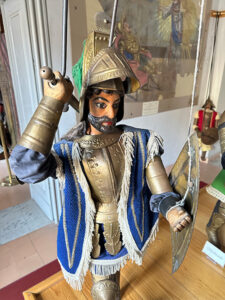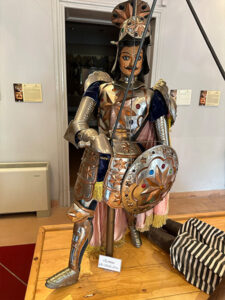ITALIAN MASKS: BETWEEN GAMES, HISTORY, AND CULTURE—Part 3
INTRO
Following the Christmas break, this month we restart our journey through Italian masks.
After the alluring baroque masks of the Venetian carnival, and the wooden ones of Sauris in part one, in part two we visited Naples and saw the different ways in which art can express the deep religiousness of the people, even by wearing masks for immersive plays.
For this third and final part, we are going to Italy’s biggest island, Sicily, to discover a unique cultural tradition, which might look familiar but of which so little is often shared. We would like to shine a light on the magnificent and original “Opera dei Pupi”.

*As a disclaimer, we would like to clarify that this article is based on the people we met and the information we gathered in the Catania region. Therefore, everything we report might not be true in other locations. Although the historical background might overall be similar, the eastern and western regions of Sicily—which have Catania and Palermo as their centers—have developed the art with some recognizable differences. In addition, the different local political and socio-economic environments in those areas might have affected how much the art has been supported and developed, in ways we are not aware of, which we will explore another time.
LET ME INTRODUCE YOU TO A SPECIAL KIND OF PUPPET
ORIGINS AND DIFFERENCES
The ancestors of the pupi, the elegant, intense-looking knights in gleaming uniforms that we know today, were fabric puppets that arrived at the court of Naples from Spain, travelling from the center of the Bourbonic kingdom to perform small theatrical shows. In the first half of the 1800s, they also arrived in Sicily, where the metamorphosis happened.

Adjustments were made to the puppets so that the stories initially told by the cantastorie (storytellers) could be acted out more realistically. Two of the strings that make the puppets move were replaced with two metal sticks, and the pupo could finally stand fiercely upright now that its head was attached to the body more solidly. The other stick, the crucial one which operates its right hand, now allowed it to make more dramatic and human-like movements: hugging, beating its chest, bringing the fist to the head and closing the visor of his helmet, and, of course, firmly holding his sword and engaging in a duel with much more accurate movements. A string still operates the left hand, which usually holds a shiny shield adorned with the symbol of the protagonist: an eagle for Orlando, a star for Erminio, and so on.

This feature distinguishes the pupi from any other puppet in the world, making them a unique creature.
Sicily is a land with historical rivalry and internal division, and this is also why there are significant differences in the making of the pupi between the eastern and western schools.
For example, the pupo is traditionally much taller and heavier in Catania; in Palermo the sword is not in the hand, but in a sheath; in Catania the pupi have straight legs, swinging in one piece from the body, while in Palermo they can bend their knees.


THE EPIC CONTENT
Despite these differences, the traditional repertoire of stories is the same. The Opera dei Pupi mainly, but not only, tells of the epic deeds of the Christian Paladins fighting against the “infidel” Saracens, and is based on the Carolingian Cycle. Also known also as Matter of France, this is one of the great European literary cycles inspired by medieval history from Charlemagne’s time (who lived between 748 and 814). The stories revolve around fundamental values of love, courage, justice, and loyalty, but also treason, power and, above all, the endless battle between good and evil.
In 2001 it was declared a UNESCO masterpiece of oral and intangible heritage, supporting the preservation of this typical expression of popular culture, which so strongly accompanied and somehow mirrored, in an epic form, the lives of the Sicilian people.

Words and pictures by Elisa Spampinato


